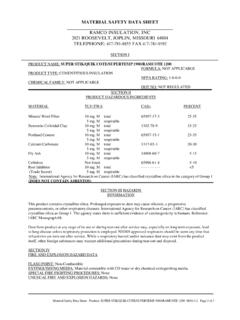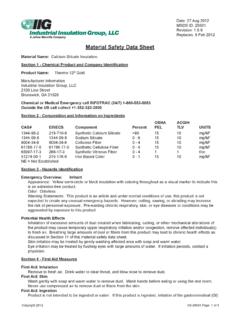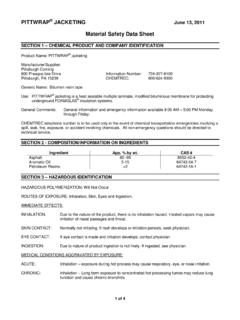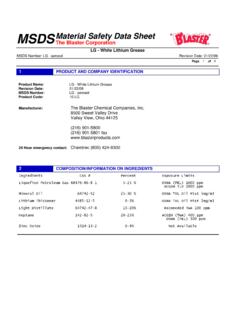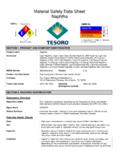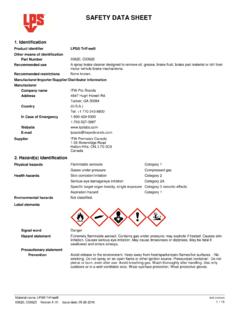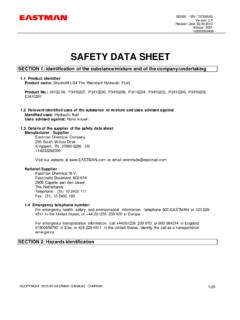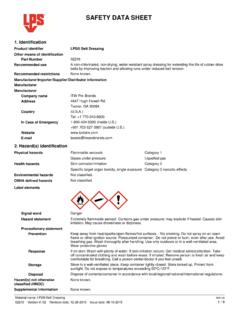Transcription of MATERIAL SAFETY DATA SHEET - ACME …
1 MATERIAL SAFETY data SHEETMSDS No: 2100 Date Revised: 09/23/2009 Revision No: 161. PRODUCT AND COMPANY IDENTIFICATIONPRODUCT NAME: GEMCO Tuff-Bond Hanger Adhesive (item #GEM03, GEM04)MANUFACTURER24 HR. EMERGENCY TELEPHONE NUMBERSITW TACCCHEMTREC (US Transportation): (800) 424-930056 Air Station Industrial ParkRockland MA 02370 Product Stewardship: (781) 878-7015 Service Number: (800) 503-69912. HAZARDS IDENTIFICATIONHAZARD DESIGNATION"F" - Highly flammable"Xn" - Harmful"N" - Dangerous for the environmentEMERGENCY OVERVIEWPHYSICAL APPEARANCE: Beige/Cream, ViscousIMMEDIATE CONCERNS: DANGER! Extremely flammable liquid and vapor. Vapor may cause flash fire and explosion. Harmful or fatal if swallowed. Harmful if absorbed through the skin. Pulmonary aspiration hazard. After ingestion, may enter lungs and produce damage.
2 High vapor concentrations may cause drowsiness. Can cause eye, skin and respiratory tract HEALTH EFFECTSEYES: Can cause severe eye irritation and corneal : Causes defatting and skin irritation. Can cause ABSORPTION: May be absorbed through the skin in harmful : Can cause gastrointestinal irritation, nausea and vomiting. Aspiration of MATERIAL into the lungs may cause chemical pneumonitis, which can be fatal. Harmful or fatal if : May cause nose or throat irritation. High concentrations may lead to central nervous system effects (drowsiness, dizziness, nausea, headaches, paralysis and loss of consciousness).SIGNS AND SYMPTOMS OF OVEREXPOSUREEYES: Liquid and vapor can severely irritate the eyes depending on type of exposure (splash, vapor) and exposure : Mild to moderate skin ABSORPTION: May be absorbed through the skin and can contribute to overall exposure.
3 Effects are similar to CNS : May result in central nervous system (CNS) depression with symptoms such as headaches, nausea, vomiting, diarrhea, dizziness, incoordination and unconsciousness. Aspiration of MATERIAL into lungs may cause chemical pneumonitis which can be : High vapor concentrations may cause CNS depression with symptoms including light headedness, giddiness, nausea, drowsiness, headache, nose, throat and respiratory tract irritation, reduced appetite, confusion, and TOXICITY: High vapor concentrations may cause central nervous system (CNS) depression with symptoms including light headedness, giddiness, nausea, drowsiness, headache, nose, throat and respiratory tract irritation, reduced appetite, confusion and EFFECTS: Damage to the nervous system of the extremeties, peripheral neuropathy, with symptoms including numbness, tingling and weakness in the toes and fingers, sensory impairment to touch, pain, vibration and temperature, muscular weakness, blurred vision, coldness of extremeties, loss of body weight and reflexes, and even paralysis.
4 Frequent or prolonged contact may irritate the skin and cause a skin rash (dermatitis).MEDICAL CONDITIONS AGGRAVATED: Any diseases or disorders relating to the skin, eyes, liver, kidney, nervous system, respiratory system, lung (asthma-like condistions) may be aggravated by exposure to this OF ENTRY: Eye Contact, Ingestion, Inhalation, Skin Absorption, and Skin Contact TARGET ORGAN STATEMENT: Central Nervous System (CNS) IRRITANCY: Eyes, nose, throat, respiratory tract, and skin HAZARDS: This product contains toluene, a chemical known to the state of California to cause birth defects or other reprodctive harm. This product contains silica, quartz, a chemical known to the State of California to cause COMPOSITION / INFORMATION ON INGREDIENTSC hemical - 13000108-88-3203-625-9F, Xn; 11-20n-Hexane5 - 20000110-54-3203-777-6F,Xn,N; 11-38-48/20-62-65-67-51/53 Low Boiling Point Naphtha -Solvent Naphtha (petroleum), Light - 10064742-89-8265-192-2Xn; 65n-Heptane3 - 10000142-82-5265-192-2F,Xi,N; 11-38-50/53-65-67 Cyclohexane1 - 5000110-82-7203-806-2F; 11 Silica, - 1014808-60-7238-878-4Xn; 48/20-40/204.
5 FIRST AID MEASURESEYES: Immediately flush eyes with plenty of tempered water (at least 15-20 minutes) lifting upper and lower eye lids occasionally. Get immediate medical : Immediately wash skin with soap and plenty of water. Remove contaminated clothing. Get medical attention if symptoms occur. Wash or dispose of clothing before : Do not induce vomiting, keep person warm, quiet and get medical attention immediately. If vomiting occurs naturally, have victim lean forward to reduce the risk of aspiration. Aspiration of this MATERIAL into the lungs due to vomiting can cause chemical pneumonitis which can be : Remove to fresh air. If not breathing, give artificial respiration or give oxygen by trained personnel. Seek immediate medical FIRE FIGHTING MEASURESFLASHPOINT AND METHOD: C (-7 F) TAG CCFLAMMABLE LIMITS: to TEMPERATURE: 204 C (399 F) to 536 C (997 F)FLAMMABLE CLASS: Class IBGENERAL HAZARD: Flammable liquid and MEDIA: Foam, dry chemical, carbon dioxide, water spray or COMBUSTION PRODUCTS: Carbon Monoxide, Carbon Dioxide, AldehydesEXPLOSION HAZARDS: Avoid fire, sparks, static electricity and hot surfaces.
6 Liquid readily evaporates at room/ambient temperature. Vapors are invisible, flammable, heavier than air, and may accumulate in low areas and spread long distances. Distant ignition and flashback are FIGHTING PROCEDURES: As in any fire, wear self-contained breathing apparatus with pressure-demand, full face piece SCBA (MSHA/NIOSH approved or equivalent) and full protective TO STATIC DISCHARGE: Likely to catch fire from near-by spark. Static charge may accumulate by flow or agitation. Grounding and bonding of containers is TO IMPACT: None DECOMPOSITION PRODUCTS: Carbon Monoxide and Carbon Dioxide may form when heated to ACCIDENTAL RELEASE MEASURESSMALL SPILL: Dike area to contain spill. Take precautions as necessary to prevent contamination of ground and surface waters. Recover spilled MATERIAL on adsorbent, such as sawdust or vermiculite, and sweep into dosed containers for disposal.
7 After all visible traces, including ignitiWe vapors, have been removed thoroughly wet vacuum the area. Do not flush to sewer. If area of spill is porous, remove as much contaminated earth and gravel, etc. as necessary and place in dosed containers for disposal. Only those persons who are adequately trained, authorized, and wearing the required personal protective equipment (PPE) should participate in spill response and SPILL: Keep spectators away. Only those persons who are adequately trained, authorized and wearing the required personal protective equipment (PPE) should participate in spill response and cleanup. Ventilate the area by natural means or by explosion proof mechanical means ( fans). Know and prepare for spill response before using or handling this product. Eliminate all ignition sources (flames, hot surfaces, portable heaters and sources of electrical, static, or frictional sparks).
8 Dike and contain spill with inert MATERIAL ( sand, earth). Transfer liquids to covered and labeled metal containers for recovery or disposal, or remove with inert absorbent. Use only non-sparking tools and appropriate PPE. Place absorbent diking materials in covered metal containers for disposal. Prevent contamination of sewers, streams, and groundwater with spilled MATERIAL or used HANDLING AND STORAGEGENERAL PROCEDURES: For professional or industrial use only. Follow label instructions. Keep out of the reach of children. Not for consumption. No smoking. Do not breathe vapors. Avoid contact with body. Turn off all pilot lights, flames, stoves, heaters, electric motors, welding equipment and other sources of ignition. Empty containers must not be washed and re-used for any purpose. Contact lens wearers must wear protective eye wear around chemical vapors and liquid.
9 Wash hands thoroughly after handling. Flammable vapors may cause flash fire or ignite explosively. To prevent build-up of vapors, use adequate natural and/or mechanical ventilation ( open all windows and doors to achieve cross ventilation). Containers may be hazardous when empty. Never use welding or cutting torch on or near container. Do not cut, drill, grind, or expose containers to heat, spraks, static electricity or other source of ignition. Explosion may occur causing injury or : Use adequate ventilation and appropriate respiratory protection to avoid breathing vapors when cover is removed. Ground and bond all equipment when handling flammable solvent-borne : Keep container closed when not in use. Store in a dry well ventilated area, out of the sun and away from ignition sources. Do not remove or deface label.
10 Prevent water or moist air from entering TEMPERATURE: C (60 F) Minimum to 35 C (95 F) Maximum SHELF LIFE: 1 year from manufacture date8. EXPOSURE CONTROLS / PERSONAL PROTECTION EXPOSURE GUIDELINESOSHA HAZARDOUS COMPONENTS (29 )EXPOSURE LIMITSOSHA PELACGIH TLVC hemical Nameppmmg/m3ppmmg/m3 TolueneTWA200 ppmNL20 ppmNLSTEL300 ppm I1'NLti]NL'2)NLt2)n-HexaneTWA500 ppm t3)1800 mg/m3 I3'50 ppm176 mg/m3 STELNLt2iNLt2)ML (2)NLt2)Low Boiling Point Naphtha - Solvent Naphtha (petroleum), Light ppmNL400 ppmNLSTELNL!2)NLWNLt2)NLt2)n-HeptaneTWA5 00 ppm t3!2000 mg/m3 t3)400 ppm1640 mg/m3 STELML ('INL<2)500 ppm2050 mg/m3 CyclohexaneTWA300 ppm t3'1050 mg/m3 t3)100 ppm334 mg/m3 STELML mNLt2)NLt2)NLt2)Silica, mg/m3 STELN\_mNLt2)NLt2)NLt2 JFootnotes:1. C = Ceiling 2. NL = Not Listed 3. OSHA limits per 29 CFR Table Z-l & Z-2 ENGINEERING CONTROLS: Provide sufficient explosion proof mechanical (general and/or local exhaust) ventilation to maintain exposure below the occupational exposure limit and exposure PROTECTIVE EQUIPMENTEYES AND FACE: Wear SAFETY glasses with side shields (or goggles) or a full face respirator.


